Dear Capitolisters,
#EndDST
Changing the clocks is anti-health, anti-science, and anti-family.
In the coming days, tens of millions of Americans and their children will participate in a silly, unhealthy annual ritual rooted in mysticism and superstition. And they’ll also celebrate Halloween.
The silly ritual to which I’m referring, of course, is our semiannual tradition of changing the clocks to accommodate daylight saving time (DST)—an onerous state time mandate detrimental to public health and safety, manipulated by corporatists, supported by a handful of childless insomniac socialites, and based on so-called “science” debunked decades ago. Indeed, even the name “daylight saving time” is a lie: The ritual merely shifts time; it doesn’t save anything—except, perhaps, a few jobs on K Street and in the Florida leisure industry.
And so, my friends, it’s time I provided a full-throated explanation of why DST should be eliminated, before it’s too late.
(i.e.,next Sunday.)
DST: A Classic Case of Government Failure
Perhaps the easiest and most obvious criticism of DST is that the policy has utterly failed to achieve its primary aim—energy conservation. Originally adopted in 1918 during World War I, reinstated during World War II, and finally made permanent under the Uniform Time Act in 1966, DST was intended to (somehow) save electricity by requiring less light in the evenings. However, real-world studies repeatedly have shown that DST not only doesn’t conserve energy, but may actually waste it. For example, a 2008 study from the National Bureau of Economic Research found that DST increased residential electricity demand in Indiana by about 1 percent, as reduced demand for lighting was more than offset by increased demand for heating and cooling, especially in cold-morning Octobers. The policy therefore cost Indiana households an extra $9 million per year, plus annual “social costs of increased pollution emissions that range from $1.7 to $5.5 million”—costs that the authors predict are likely even higher in other parts of the United States. Indeed, DST’s net energy drain is probably even bigger today, as it’s been extended into November (thus raising heating/cooling costs) while electricity savings from keeping the lights off have shrunk because today’s light bulbs are more efficient (and thus cheaper to keep on).
A separate study from Australia made similar conclusions, finding that decreased lighting use in the evenings was offset by increased use in the mornings. And that’s just electricity. Other studies show that DST could increase other types of energy consumption. For example, a 1993 study found that DST causes both “a rise in evening traffic and … an increase in fuel consumption and hence a higher pollution level in the atmosphere,” as well as “a rise in secondary pollutants” due to shifted traffic patterns. Others have found the same. Overall, there’s no evidence that DST significantly decreases energy consumption.
Despite this policy failure, DST not only persists but actually has been repeatedly expanded to cover more and more of our year, thanks—as Michael Downing, author of Spring Forward: The Annual Madness of Daylight Saving Time, explains—to intense lobbying by the U.S. industries that benefit financially from lighter evenings. Contrary to the conventional wisdom, however, it wasn’t farmers who wanted DST—they actually opposed it because they “now had an hour less of morning light to milk their cows and get their goods ready for market, let alone for commuters or children waiting for school buses in the dark.” Instead, the original, post-war implementation of DST was driven by the oil and gas companies that enjoyed the additional gasoline consumption. The gas and fuel industries were then joined by the golf, home improvement, and barbecue/patio industries to lobby for the 1986 expansion of DST from six to seven months, because each industry gained hundreds of millions in additional sales revenue each year because of the extended evening daylight hours. Finally, the 2005 expansion of DST—from seven months to eight (second Sunday in March to first Sunday in November)—was driven by the National Association of Convenience Stores (NACS) and U.S. candymakers, each of which wanted Halloween to occur during DST because it boosted candy and, again, gasoline sales. “It gave the children more time to trick or treat and eat more candy … and the NACS credits that extra month of daylight saving with a $1 billion increase in annual [gasoline] sales.” (Big Candy also supported the 1986 expansion but had to lobby for another two decades before achieving the Halloween breakthrough.)
As we’ve discussed, political pressure has long kept many U.S. government programs afloat for decades after they’ve been proven to be “unqualified failures.” DST is no different.
DST Is Anti-Health and Science
The policy also imperils Americans’ health and safety. For starters, the semiannual time change results in all sorts of maladies in the days thereafter: car crashes and pedestrian deaths; workplace injuries; heart attacks and strokes; depression; and “adverse medical events” because of “human error.” (Mental note: Don’t get hurt/sick on time-change weekends.)
A switch to permanent DST, moreover, wouldn’t solve many of the policy’s current risks. For starters, dark mornings caused by DST in April and October endanger millions of children forced to wait for the school bus before sunrise. Indeed, “when temporary, year-round DST was adopted in response to an Organization of the Petroleum Exporting Countries (OPEC) oil embargo, increased fatalities among school-aged children in the morning were noted between January and April. These findings may be due to darkness lasting longer in the morning when children are traveling to school, while other factors also may be at play.”
Dead children. My God.
DST also causes health problems for adults because it screws with our natural circadian rhythms. As the Wall Street Journal explains:
The fall-winter clock, known as standard time, is closer to the sun’s natural rise and set, meaning it is more aligned with our internal clocks that tell us to sleep at night and wake at daylight. When clocks spring ahead in March and daylight lasts longer in the evening, the cues to go to sleep come later than our biological clocks are accustomed to, says Till Roenneberg, a sleep researcher and professor of chronobiology at the Ludwig Maximilian University of Munich.
Put another way, timekeeping (and, thus, our clocks) evolved over centuries to have the sun peak overhead at noon in most places, but DST radically shifts the clock so that the sun peaks much “later” in the day—thus screwing with our internal clocks. As shown in the following chart, for example, DST causes the sun on June 21 (the longest day of the year) to reach its proper, noontime position at almost 3 p.m. in several parts of the country:
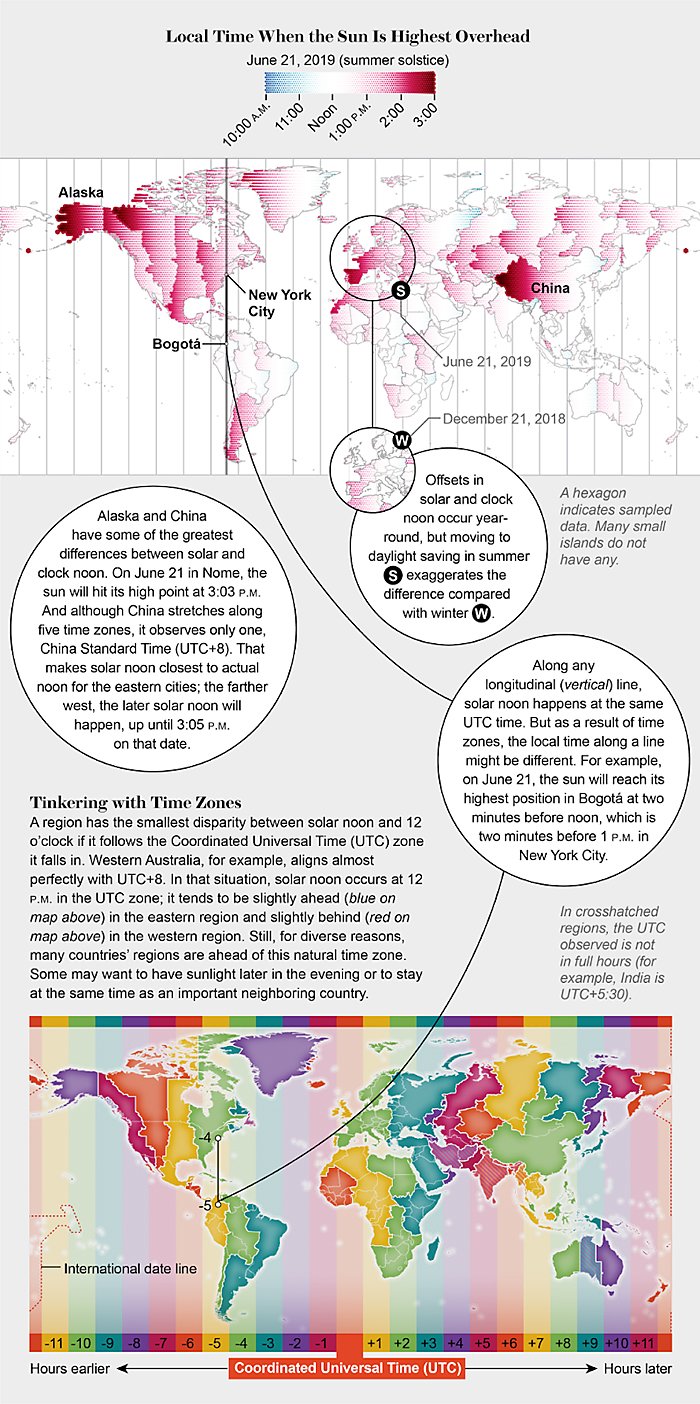
Given how this disrupts our biological clocks, many health experts, chronobiologists, and medical organizations have called for DST’s elimination. In fact, the American Academy of Sleep Medicine—joined by dozens of other, very reputable medical organizations—last year published a detailed “position statement” in the prestigious Journal of Clinical Sleep Medicine advocating a change to permanent standard time because it is “best aligned with human circadian biology and has the potential to produce beneficial effects for public health and safety.” They further cite the scientific research to back their position up:
DST is less well-aligned with intrinsic human circadian physiology, and it disrupts the natural seasonal adjustment of the human clock due to the effect of late-evening light on the circadian rhythm. DST results in more darkness in the morning hours, and more light in the evening hours. Both early morning darkness and light in the evening have a similar effect on circadian phase, causing the endogenous rhythm to shift to later in the day. There is evidence that the body clock does not adjust to DST even after several months. Permanent DST could therefore result in permanent phase delay, a condition that can also lead to a perpetual discrepancy between the innate biological clock and the extrinsic environmental clock, as well as chronic sleep loss due to early morning social demands that truncate the opportunity to sleep. The chronic misalignment between the timing of demands of work, school, or other obligations against the innate circadian rhythm is called “social jet lag.” Studies show that social jet lag is associated with an increased risk of obesity, metabolic syndrome, cardiovascular disease, and depression.
Real-world experiments with permanent DST confirm these harms, which outweigh any possible public safety benefits (benefits that a few more streetlamps could also achieve, by the way). Russia, for example, “tried to go on permanent summer time, but changed to permanent winter time in 2014 after the summer-time-in-winter change gave people stress and health problems when it stayed darker for longer during winter mornings.”
But, hey, at least Big Candy is happy.
DST Is Anti-Family
Misguided DST advocates often claim that unnaturally light evenings benefit children because they can play outside later, but this argument falls flat for several reasons. First, as already noted, DST’s dark mornings endanger these same children—put simply, little Timmy can’t play baseball at 9 p.m. if he’s been permanently maimed in a morning bus accident. Second, DST’s time-changes, dark mornings, and bright evenings make it harder for parents to get their kids up for school or to bed at night—decreasing the children’s sleep quality, destroying meticulously scripted sleep schedules, and dramatically increasing family strife (trust me). None of this is good for kids’ or parents’ health or sanity—no wonder, then, that parents (well, the good ones, at least) hate DST with such a passion.
Finally, the kids would still have plenty of time to play in the evenings during the months most amenable to outside play. As this Washington Post example shows, for example, dusk would still be after 6 p.m. between March and September and after 7 p.m. May through August. (And it wouldn’t be truly dark for even longer.)
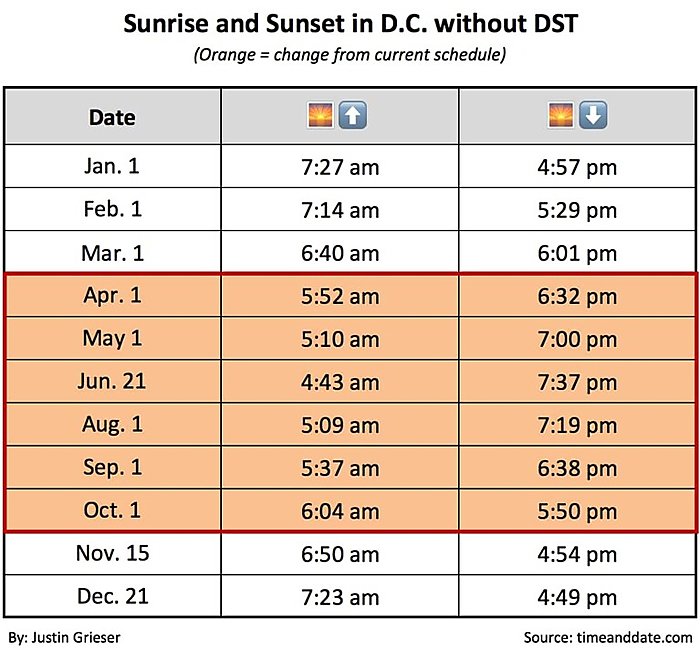
Sure, some late-night revelers who overindulged might struggle with a few light mornings in the summer, but personal suffering is often the only way to learn needed life-lessons, and that’s what blackout curtains are for, anyway.
As an aside, the table above gets to two massive errors that today’s DST zealots usually commit, i.e., that standard time causes shorter days instead of just aligning clocks with the sun and human biology, and that DST is more reasonable because it reflects most Americans’ waking hours. The former claim is flat-earther nonsense that ignores the earth’s tilt and thus deserves no further mention. The latter claim, on the other hand, might seem more legitimate but turns out to be equally absurd. As this excellent analysis (with interactive maps!) shows, in fact, there are far more unreasonably dark mornings under permanent DST than there are unreasonably dark evenings under permanent standard time—even when using a far-too-late 7 a.m. start to the day:
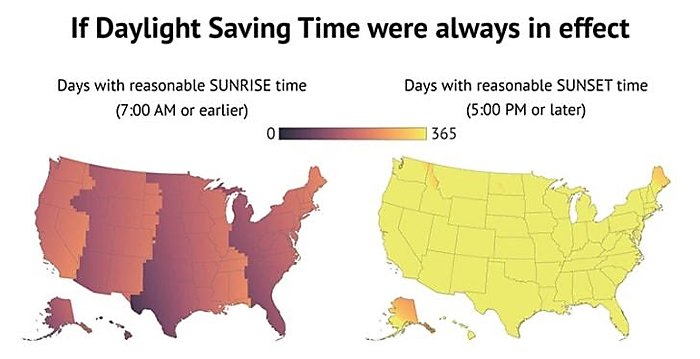
Even the current system—with the time changes and their myriad health/safety problems—severely disadvantages reasonable mornings in the vast majority of the country:
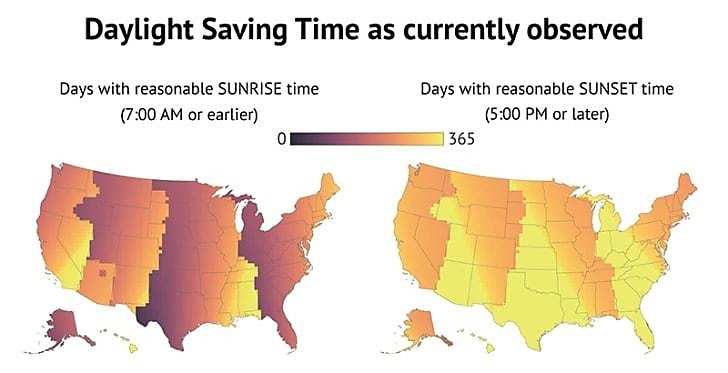
It’s thus a myth that DST is somehow a “fair” or “reasonable” balance between productive families who need lighter mornings and lollygagging singles who want to do Lord-knows-what all night. The system is heavily biased toward the latter.
No wonder American birth rates are falling.
DST Is Anti-Economy
DST’s supposed economic benefits have also been wildly oversold. Sure, the fat-cat golf industry and its leisure industry co-conspirators might benefit from unnaturally light evenings, but those “gains” come at many others’ expense. For starters, companies that could benefit from longer, lighter mornings—cafés, fitness centers, airports, etc.—are on the losing end of this redistribution, forced to enrich the leisure cronies with their hard-earned business. Then there are the broader economic harms. The semi-annual time switch, for example, is associated with decreased workplace productivity (“cyberloafing”), missed workdays due to injury, financial market losses, and harsher criminal sentencing by sleep-deprived judges. Thus, researchers have found that DST’s time change alone costs the American economy hundreds millions of dollars each year—and “we don’t regain that productivity when the fall change adds an hour to our schedules.”
It’s all but certain, moreover, that DST’s permanent health harms (e.g., the aforementioned “social jet lag”) also undermine American workers’ performance. Indeed, research shows that adults’ peak productivity and analytical performance occur in the morning (thanks again to those circadian rhythms), while mundane tasks are best left to the afternoon. National surveys show much the same, with workers’ peak productivity time occurring before noon in all but four states (and none after 3:30 p.m.). DST’s anti-morning bias thus likely harms national productivity (and thus the economy), even after the time-change fatigue wears off. (Sure, this doesn’t apply to a few weird night owls, but studies show they just never matured.)
The Slippery Slope
Finally, there is the continued risk that the government—funded by Big Business and drunk with power over time itself—takes its interventions too far, with dangerous or even absurd results. Don’t believe such a slippery slope exists in this case? Well, then feast your eyes upon what Australia just did:

A simple return to time originalism (aka, permanent standard time)—and thus a commitment to keeping our clocks as closely aligned to nature as possible—is the only way we can eliminate the incentive for K Street lobbyists and Beltway Insiders to do something equally ridiculous.
Summing It All Up
Daylight saving time hasn’t achieved its primary public policy goal—energy conservation—and may actually undermine it, imposing significant environmental, health, safety, family, and economic harms along the way. Despite these facts, lobbying by powerful industry groups and a handful of late-sleeping lollygaggers not only has protected this failed government program, which annually steals an hour of our lives and months later returns it interest-free, but has actually expanded it—thereby thrusting tens of millions of American workers and families into abject darkness for even longer.
Cynics might say that change here is impossible, that the forces of Big Business and American political dysfunction are too strong to overcome, but such pessimism ignores history both here and abroad. Countries around the world, for example, have ditched the practice in recent years, and Europe could be next: In 2018, the European Parliament voted 384–153 to review “whether Daylight Saving Time is actually worth it,” due to “growing dissatisfaction” with the system. Here at home, Americans have beaten back the DST menace not once, but twice—abandoning it after WWI (“it proved unpopular”) and again in the 1970s, after those unfortunate bus stop accidents.
Let’s hope that it doesn’t take even more needless harm to our children before we act again.
Chart of the Week
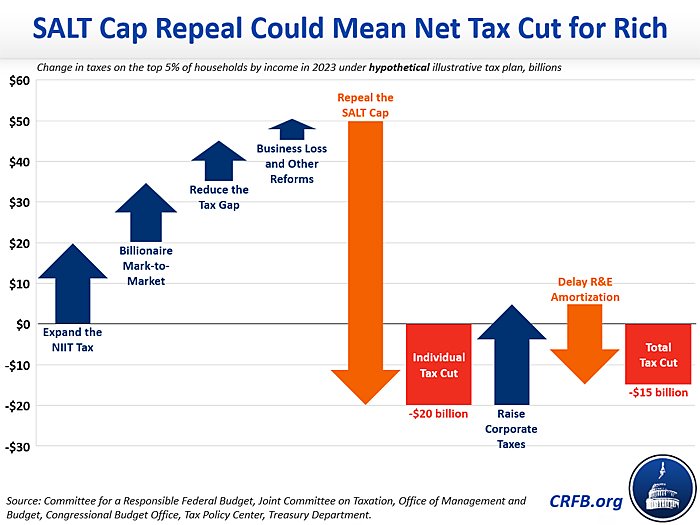
The Links
Me, on more bad policies mucking up our supply chains and unnecessary port spending in the infrastructure bill
Biz groups ask Biden to delay vax mandate
Another supply chain impediment: NIMBYism
Left-leaning Texas transplants choose economic policy over social policy
Taxes and regs are killing California’s legal weed business
Study on Big Sugar buying votes
Trade and commerce support tolerance and peace
Canada opposes proposed U.S. tax credits for “American made” EVs
“No end in sight” for labor shortages?
“The Billionaire Tax: The Worst Tax Idea Ever?”
The feds granted a dumb patent, then violated it, then paid $100 million in damages
Important update on Zillow turning us into a nation of renters
Hong Kongers find refuge in struggling Blackpool
Georgia man used his pandemic relief loan to buy a $57,000 Pokémon card
